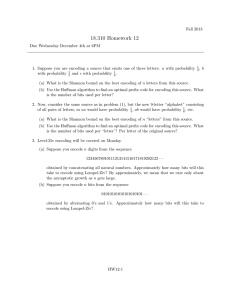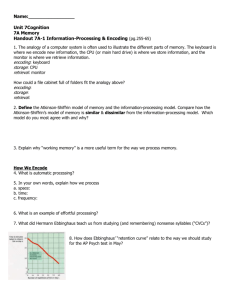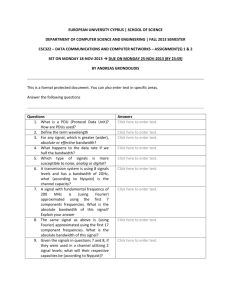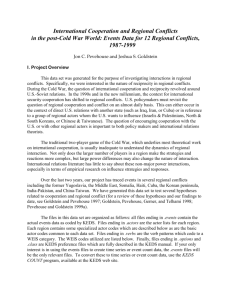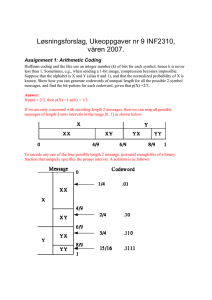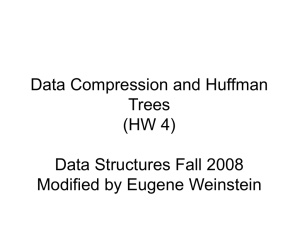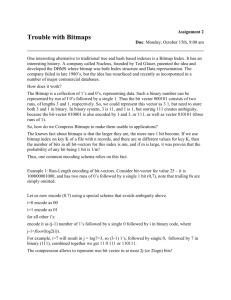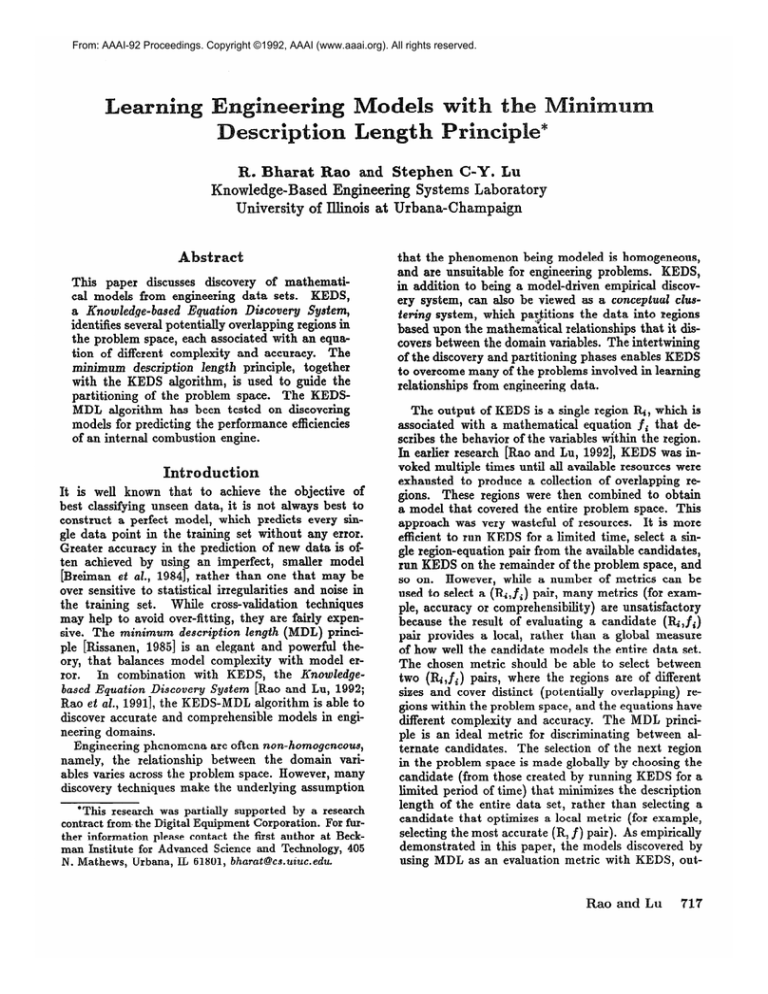
From: AAAI-92 Proceedings. Copyright ©1992, AAAI (www.aaai.org). All rights reserved.
harat Rae
and Stephen
C-Y.
Knowledge-Based
Engineering Systems Laboratory
University of Illinois at Urbana-Champaign
Ahtract
This paper discusses discovery of mathematical models from engineering data sets. KEDS,
a Knowledge-based
Equation Discovery
System,
identifies several potentially overlapping regions in
the problem space, each associated with an equation of different complexity and accuracy.
The
minimum description
length principle, together
with the KEDS algorithm, is used to guide the
partitioning of the problem space. The KEDSMDL algorithm has been tested on discovering
models for predicting the performance efficiencies
of an internal combustion engine.
It is well known that to achieve the objective of
best classifying unseen data, it is not always best to
construct a perfect model, which predicts every single data point in the training set without any error.
Greater accuracy in the prediction of new data is often achieved by using an imperfect, smaller model
[Breiman et al., 19841, rather than one that may be
over sensitive to statistical irregularities and noise in
While cross-validation techniques
the training set.
may help to avoid over-fitting, they are fairly expensive. The minimum description length (MDL) priuciple [Bissanen, 19851 is an elegant and powerful theory, that balances model complexity with model erIn combination with KEDS, the Knowledgeror.
based Equation Discovery System [Rao and Eu, 1992;
Rao et al., 19911, the KEDS-MDL algorithm is able to
discover accurate and comprehensible models in engineering domains.
Engineering phenomena are often non-homogeneous,
namely, the relationship between the domain variables varies across the problem space. IIowever, many
discovery techniques make the underlying assumption
*This research was partially supported by a research
contract from. the Digital Equipment Corporation. For further information please contact the first author at Beckman Institute for Advanced Science and Technology, 405
N. Mathews, Urbana, IL 61801, bharat@cs.uiuc.edu.
that the phenomenon being modeled is homogeneous,
and are unsuitable for engineering problems. KEDS,
in addition to being a model-driven empirical discovery system, can also be viewed as a coatceptzsal clusteting system, which pastitions the data into regions
based upon the mathematical relationships that it diicovers between the domain variables. The intertwining
of the discovery and partitioning phases enables KEDS
to overcome many of the problems involved in learning
relationships from engineering data.
The output of KEDS is a single region IQ, which is
associated with a mathematical equation bi that describes the behavior of the variables within the region.
Iu earlier research [Rao and Eu, 19921, KEDS was invoked multiple times until all available resources were
exhausted to produce a collection of overlapping regions. These regions were then combined to obtain
a model that covered the entire problem space. This
approach was very wasteful of resources. It is more
efficient to run KEDS for a limited time, select a single region-equation pair from the available candidates,
run KEDS on the remainder of the problem space, and
so on. Bowever, while a number of metrics can be
used to select a (l&J;) p air, many metrics (for example, accuracy or comprehensibility) are unsatisfactory
because the result of evaluating a candidate (IQ,fi)
pair provides a local, rather than a global measure
of how well the candidate models the entire data set.
The chosen metric should be able to select between
two (l&J;)
pairs, where the regions are of different
sizes and cover distinct (potentially overlapping) regions within the problem space, and the equations have
different complexity and accuracy. The MDL principle is an ideal metric for discriminating between alternate candidates. The selection of the next region
in the problem space is made globally by choosing the
candidate (from those created by running KEDS for a
limited period of time) that minimizes the description
length of the entire data set, rather than selecting a
candidate that optimizes a local metric (for example,
selecting the most accurate (R, f) pair). As empirically
demonstrated in this paper, the models discovered by
using MDE as an evaluation metric with KEDS, out-
Rae and Lu
717
{A)&{B)arcrcgions
ill disspace.
Figure 1: KEDS: (a) Sampling the data set, (b) Computing covers, & (c) Partitioning the problem space
perform those created
by KEDS with other metrics.
The KEDS-MDL algorithm presented in this paper is
a multi-dimensional extension of the MDL surface reconstruction algorithm presented in [Pednault, 19891
(which applied to functions of a single variable).
A variety of tools have been applied to form engineering models (see [Finger and Dixon, 19891). Statistical techniques like CART [Breiman et ol., 19841
and MARS [Friedman, 19911, and machine learning
techniques like ID3 [Quinlan, 19861 and PLS [Rendell, 19831, may be characterized as split-and-fit systems, which first partition (split) the problem space
and then successively model (fit) each region. KEDS
is a fit-and-split system which builds up hypotheses
in a bottom-up fashion and partitions the problem
space to find the enclosing region. Techniques like
those in [Kadie, 19901 can be used to combine multiple overlapping hypotheses. Some traditional empirical
discovery systems [Langley et oz., 1987; Falkenhainer
and Michalski, 19861 perform well when the equations
that best describe the data have relatively small integer coefficients and the problem space does not have
to be partitioned into several regions. AIMS (Adap
tive and Interactive Modeling System [Lu and Tcheng,
1991]), integrates machine learning and optimization
techniques to aid engineering decision making. Conceptual clustering programs [Stepp, 1984; Fisher, 1985;
Cheeseman et al., 19881 produce partitions superior
in comprehensibility to those discovered via numerical clusterings. However, the mathematical relationships that exist between attributes of the events are
not used to partition the events. The MDL principle has been used to infer decision trees [Quinlan and
Rivest, 19891, for image processing [Pednault, 1989;
Pentland, 1989; Leclerc, 19891, and for learning concepts from relational data [Derthick, 19911.
The KEDS System
Given
:
A training data set with n data points, E =
, err). Each data point e has a response (or dependent) attribute y, and P predictor (or independent)
All of y and 2; are realattributes, 2”= x1,x2,...,xp.
valued and continuous variables (although nominal variables are acceptable as well).
.
(el,e2,...
Goal
718
:
From E , build a model Q that predicts the value
Representation
and Reasoning:
Qualitative
of v from any given set of values of 3: & = Q (Zi).
In addition to the above data set, KEDS is provided with some generalized knowledge about the relationships that we expect to find in engineering domains. KEDS generates models of the form g = F(Z),
where F is a model chosen from a collection of parameterized polynomial models provided to, KEDS. For
the experiments in this paper we have considered five
different families of parameterized models: y = a,
y = ax2 + bx + c, y = axI + bx2 + c, and
Y =ax+-b,
Y = ax1 + bx2 + cx3 + d, where the x’s are the nominal
parameters of F (the names of the real-valued predictor variables pi that are assigned to F), and a b . . .
are the real-valued parameters (coefficients discovered
by KEDS). The equation templates provided to KEDS
correspond to the basis functions used in statistical
methods like linear regression. Since the domain can be
non-homogeneous, the underlying function that generated the data is assumed to be of the form {RI 3 y =
J%(x) + p(m), R2 SJ y = h(x) + p(m) . . .) where
p(u) represents a O-mean Gaussian process, and & is
a region in predictor space.
The KEDS algorithm consists of two-phases: discovery and partitioning.
The partitioning is model driven
and is based upon the relationships that are discovered
from the data, while the discovery process is restricted
within the boundaries of the regions created by the
partitioning. In the initial discovery phase, an equation template F is chosen and the data set E is sampled
to determine the coefficients of a candidate equation,
f. This is illustrated in Figure l(a) for the template
Y = ax + b, where two separate candidate equations
are created (based on two distinct instantiations of the
initial discovery phase). Note that the horizontal axis
in Figure 1 is multi-dimensional,
representing the Pdimensional space of predictor variables.
In the partitioning phase, the deviation Ayi between
the actual and predicted value for each data point ei,
is converted into a positivity score via a score function.
This is illustrated in Figure l(b) for a very simple score
function, where all data points with deviation Ay; 5 E
are assumed to be positive examples of fwith a score
of 1, and all other data points are negative examples
with a score of 0. The training data set E is partitioned
over the space of predictor variables to isolate regions
Model
Construction
1. For a template F with k unknowns, repeat Step 2 below,
N(F, k, S) (see Equation 1) times.
2. Initialize S to k random samples from the data set E a
3. Discovery: determine the k coefficients of f from S.
4. Partitioning:
(a) For all examples in E , compute
positivity-score( f , e;) = exp( -( Ay;)2/2u2).
(b) Partition E to return regions Rwith high score.
(c) for crllR; (subject t o m): set S to events e E Ri.
5. Return to Step 3 and refine f, until f ceases to improve.
Figure 2: The KEDS algorithm
with a low error (Ce., high score), as in Figure l(c).
The score for a region is the average of the scores of
the data points in the region. The discovery phase
is then invoked in each region to refine the candidate
equation. Since we are using polynomial equations, we
can perform multi-variable regression over the events
in the region to improve the values of the coefficients.
The KEDS algorithm is summarized in Figure 2.
KEDS uses three parameters to control its search
for formulae. The accuracy parameter, is a score function that converts the deviation into a positivity score.
The score function creates a transformation of the
data set, wherein the score associated with each data
point measures the likelihood that the data point is
correctly predicted by the candidate equation. The
sim le score function shown in Figure l(b) was used
in PRao et al., 19911. The score function used here,
is the normalized probability deneXp(-(Ay@/2u2),
sity function for a normal distribution (see Figure 2).
The size parameter, m, is the minimum fraction of
the events in the data set that must be described by a
equation. For the two regions A and B found in Figure l(c), region B is rejected because it covers fewer
events than permitted by m. The cover of the formula
f is modified to (the set of events in) region A. Note
that the regions A and B are hypercubes in the Pdimensional predictor space. The choice of PM [Rendell, 19831 as the partitioning algorithm imposes the
constraint that these regions be defined by conjunctive
concepts over the discriminant attributes.
The confidence parameter, 5, controls the number
of times N(F), that the KEDS algorithm is called for
a given template F. If all 6;: data points are chosen
from a region associated with an equation, experiments
with synthetic data sets with added Gaussian noise
have shown that KEDS quickly converges to the correct
equation and region. KEDS find regions that cover m
fraction of the events with a (high) probability (1 - a).
If a given template F has I%unknown coefficients, then
it follows that the total number of times N(F), that
the KEDS algorithm needs to be instantiated for F
(Step 1 in Figure 2), is:
log 6
N(F) 2
log(1 - mk)
According
to the Minimum
Description
Length priu-
ciple [Rissanen, 19831, the theory that best accounts
for a collection of observations E = {el, e2, . . . , e,) is
the one that yields the shortest description [Bissanen,
1985; Barron, 19841. Therefore, the best theory to induce from a set of data will be the one that minimizes
the sum of the length of the theory and the length of
the data when encoded using the theory as a predictor for the data. Let Q be a model created from the
region-equation pairs discovered by KEDS. Then the
model that will be the best predictor of yet unseen data
will be the model & , that minimizes the length:
~(Q,E)=C(&)+d:(EIQ)
(2)
where C (& ) is th e number of bits required to encode
the model & , and t (E ]Q ) is the number of bits
needed to encode the &#erence between the training
data set
and the values predicted for the events in
by Q . The L (Q ) term in Equation 2 corresponds
to a complexity penalty (increasingly complex models
will require a greater number of bits to encode) and the
C (E ]& ) term corresponds to an error penalty. These
two terms create a balance between modeling the data
accurately and overfitting the data.
There are different encoding techniques that can be
used to encode the total code length L: (Q , E ). It
is important that these coding techniques be efficient.
An inefficient method of coding the model will penalize larger models too heavily, and will result in the
selection of smaller models with large error. Similarly,
an inefficient method for coding the difference term
C (E 1Q ), will result in complex, overly large models
being selected.
Encoding the Model - L (Q ) Consider the simple case where the model is composed of exactly one
equation f (i.e., Q = f ). As we are working with a
fixed family of models, such that the description of the
family does not depend upon E or the parameters used
in the models, L (f) is the cost of encoding the family F of f, plus the cost of encoding the values of the
parameters in d. For the experiments in this paper,
we have considered five families of models (Section 2).
Therefore, the cost of encoding F is log 5 bits (all logarithms in this paper are base 2). If F takes w predictor
variables and all the P predictor variables can be assigned to F with equal probability, then encoding the
nominal parameters off costs log (f) bits. Each of the
u real-valued coefficients off requires i log 7~bits [Rissanen, 19831 to encode. An additional $logn bits are
needed to encode u2, the value of the variance used
later in Equation 5 to calculate the difference term.
(u+
c (f) =log5+log(,B)+ yAs the domain
piecewise-continuous
‘)logn
(3)
is non-homogeneous,
& is a
model that is a collection of
Rao and Lu
719
region-equation pairs. If Q is divided into T regions
[RI,... R,.] and a unique equation fj is associated with
each region Ri, then the cost of encoding & is
7
C (E
IQ) = % 10g(2?ra2)
+
loge
x
AYZ
s
(5)
e;EE
?
the
Exce
An individual (R, f)
pair can be encoded by
ns 4 and 5. Our goal is
to evaluate the entire model, and yet somehow select
equations one at a time rather than having to evaluate
the model only after it is completely formed. We do
this by dividing Q into two models: Qeqn, consisting
of all the equations chosen in & 9 and Qeze,
of all the exceptions in Q (i.e., the events in
not covered by the equations in Qepn). Qezcls enco
by fitting the exceptions to an averaging model (the
mean value of the exceptions). The code length of the
averaging model is computed using Equation 4, while
Equation 5 is used to calculate the difference term for
the exceptions. The code length L (QcZc) is a measure
of the randomness of the exceptions.
Encoding
j=l
j=l
?
=
Wr) + xlL
j=l
(4)
tRj) + L (fj)l
where X(T) is the number of bits require to encode the
integer T. According to the Elias-Cover-Rissanen prior
for integers, the number of bits needed to encode T is
l
ssanen9 19831. Mowever, this encodlog*(P+1)+4J
ing is optimal only for relatively large integers, and is
inefficient for the small number of regions that occur
in & . It is more efficient to use a fixed number of bits
to encode T. Note that when comparing two models,
the A(V) term cancels out and can be dropped from
Equation 4.
A region R is a hypercube in the space of the predictor variables Z9 and is defined by a collection of I
intervals on some, none, or all of the l? predictor variables. Instead of using the Elias-Cover-Rissanen prior
to encode I, it is more efficient (for small P) to use
P bits to indicate the presence or absence of each of
the predictor variables. An interval over the variable
zj can be written as [loj < zj < hij]. While it is possible to encode both the interval end points loj and
hii, we note that for an arbitrary interval either loj
or hij could be the boundary value for variable zj.
We can take advantage of this and significantly reduce
the code length for intervals that begin or end at a
boundary value, while increasing it slightly for other
intervals. To encode the three different possibilities
(i.e., either loj or hij is a boundary value or neither is)
costs log3 bits. If L is the number of bits to encode
an interval end-point that is not a boundary value, an
additional L or 2L bits are needed to encode the interval completely. Encoding the interval end-points with
full precision costs log n bits, but this is obviously too
costly as we only use i log n bits to encode the parameters for f. Encoding with reduced precision is used to
get a smaller cost for L.
Encoding
the
Difference
Term
-
L (E IQ )
Again, consider the case when Q is composed of a
single function f. To encode the data points in E 9
the difference between the actual value of the response
variable y and the value jj predicted by the model Q is
analyzed statistically by viewing the difference as a
random process. This random process along with the
model Q induces a probability distribution p on the
data points, where p is the maximum likelihood function. From the Shannon coding measure in information
theory [Gallager, 1968]9 we can encode the data points
using a number of bits equal to the negative log likelihood (- log p(E )). When Q is a collection of regions,
Equation 5 (below) is applied to each region.
720
Represent
at ion and Reasoning:
e Variance
The nearest neighbor
alculated by using the nearest neighbor of a point in a normalized predictor variable
The true variance
space as the best estimate $.
of Eis assumed to be CY~ = u&J2 [Stone, 1977;
Cover, 19681. Note that u must be estimated separately for each region (the only assumption made is
that the variance is constant within a region). Encoding the value of u accounts for the extra !J log n bits in
Equation 3.
Once a region has been modeled by an equation
f 9 the deviation from f itself can be used to calculate u. Then the cost of encoding the difference term
for a region (from Equation 5) reduces to L (R ]fi) =
ni log(&%).
This seems counter-intuitive at first;
for low values of u, the code length L (& ]fi) is negative. Mowever, the t~-~term in Equation 5 should actually be a a2/lJ2 term, where l? is the precision used in
representing the data. Obviously I’ < u and log(u/r)
will always be positive. Note that when comparing two
candidate equations, the log(l/y) term cancels out,
and therefore, can be ignored. The value for the code
length t (E IQ ) is simply a relative rather than an
absolute value.
L Algorithm
The KEDS-MDL algorithm (summarized in Figure 3) calls KEDS iteratively and uses MDL as an evaluation metric to select
the best candidate at the end of each loop. The total available resources, N(F) for each template F are
calculated via Equation 1, and are divided among I
iterations. At the end of each iteration the candidate
that minimizes the description length L (Q ) of the
data set, is added to Qeqn, and the data points within
the region are removed from Qezc. This continues until
no exceptions remain or the description length cannot
be reduced. For the purposes of this paper, the available resources N(F) are divided equally among the I
iterations.
C&alit at ive Model
Construct
ion
Table 1: Predictor 8c Response variables in OTTONET
1. Q eqn = (), &em = (E}, determine Mi(F), i 5 I.
2. For each F, call KEDS iVi(F) times.
3. For each R, f : Qesc = Qeac - R, Qeqn = Qeqn+ f .
Compute d: (Q ).
4. Select R, J that minimizes L (& ).
5. Return to (2) unless Qezc = () OPI iterations done.
Figure 3: The MEDS
Ottonet [Assanis, 19901, a simulator for an internal
combustion engine, was used to provide the data for
KEDS. The predictor (input) and response (output)
variables for the internal combustion engine domain
are shown in Table 1. The input variables were randomly varied over the ranges shown in Table 1, to generate 300 events, 50 of which were randomly set aside
to create a test set. The remaining 250 events were
used as a training data set for the two sets of experiments described below.
: In the first series of experiments, the
Experirment
parameters were set at 1pz= 0.3 and 6 = 0.1. Three
separate experiments were run. (a) KEDS was run in
a breadth first fashion and the results were combined
at the end to produce a model. (b) KEDS-MDL was
run with the same resources as in La. (c) KEDS-MDL
was run again with the available resources reduced by
a factor of 10. In the KEDS-MDL experiments (Lb
and I.c), the available resources were divided equally
among four iterations (i.e., Ni(F) = N(P)/4,i
<, 4).
The models were used to predict the attribute values of the test events (the test events were not part
of the data set seen by KEDS). The models were evaluated in terms of the predictive error and the model
creation time (in seconds on a DECStation 5000). The
results are summarized in Table 2. Note that even
with the same available resources, KEDS-MDL (Experiment Lb) took less time than in Experiment La.
This is because the limitation of available resources
refers to the maximum number of times M(F) that
the KEDS algorithm may be called. On the surface,
although the KEDS algorithm appears to be independent of the number of data points n, the discovery and
partitioning steps (Steps 3 and 4 in Table 2) depend
heavily on n. As KEDS-MDL discovers regions and
adds them to Qeqn, n decreases on each iteration.
What is also very interesting is that even when
provided with limited resources (one-tenth that available in La and Lb), KEDS-MDL learned models that
(IC engine simulator)
were extremely competitive with those that had been
learned using full resources. This indicates that the
MDL metric, is effective even with extremely limited
resources.
xperiment
: These series of experiments were designed to compare the performance of different metrics
for model discovery. Using the same limited amount of
resources available in 1.c above, a second series of experiments were run with the following four metrics for
model selection: (a) MDL (identical to I.c), (b) UCCUrcacy, the most accurate equation was chosen, (c) gize,
the region that covered the maximum number of events
was chosen, and (d) goodness (= accuracy * size). In
each
iment the appropriate metric was used in
place
DL in Steps 3 and 4 in Figure 3, to choose
a region-equation pair in each iteration.
The generated models were evaluated for predictive
error for all the response variables. The results are
presented in Table 3. As can be seen KEDS-MDL outperformed the KEDS algorithm using other metrics.
Below is the model created for the response variable
qVOrin Experiment IIc (using KEDS-MDL with limited resources).
[CR > 7.21 [IPI > 0.5731 *
?&lo1= 0.63 CR + 18.78 PI + 75.3
ELSE [PI < 0.5731 q
%I01 = 1.88 CR + 50.03 PI - 1.68 @ + 48.88
Csnclusions
In this paper, we have defined an encoding schema
for the models discovered by KEDS, and demonstrated
that MDL can be used as an evaluation metric to efficiently acquire models from complex non-homogeneous
domains. In the future we intend to apply KEDSMDL to other engineering domains, such as modeling
the delay of a VLSI circuit. KEDS will be enhanced
so as to consider domain knowledge other than equation templates (for example, analyzing the topology of
a VLSI circuit to determine various possible critical
paths). The KEDS-MDL algorithm was motivated by
our overall goal of developing a methodology to support engineering decision making. Under this methodology, called inverse engineering, the models discovered
by KEDS-MDL will be used to directly support synthesis activities in engineering decision-making. This will
greatly reduce design iterations and take advantage
of the design expertise already captured in computerbased analysis tools.
Rao and LU
721
Var
(a) Breadth-first
Error
RunTnne (s)
0.00639
0.00765
_ TV01 0.00511
.
4701
1956
5151
V9T
rlrcet
(b) KEDS-MD&
Error
RunTune (s)
0.00312
0.00724
0.00365
1411
572
1222
(c) KEDS-MDL:(
I/IO)
RunTIme s
Error
0.00685
0.00838
0.00395
89
237
168
Table 2: Experiment I: Comparing KEDS (breadth-first) with KEDS-MDL
0
Metric
11Error: qfl 1 Error: Get 1 Error: qvor 1
Gallager, R.G. 1968. Information
Theory
Communication. John Wiley & Sons.
and Reliable
Kadie, C.M. 1990. Conceptual Set Covering: Improving
fit-and-split algorithms. In Proc. of the Seventh International Conference on Machine Learning, Austin. 40-48.
Table 3: Expt II: Predictive Error for differentMetrics
Acknowledgments
We are grateful to Jorma Rissanen for his comments and
suggestions. Our thanks also go to Dennis Assanis for the
OTTONET
data, to Robert Stepp and Bradley Whitehall
for help while developing KEDS, and to Edwin Pednault
for introducing us to minimum length encoding.
References
Assanis, D.N. 1990. OTTONET.
Technical Report, Department of Mechanical and Industrial Engineering, University of Illinois, Urbana, IL.
Barron, A.R. 1984. Predicted Squared Error: A criterion
for automatic model selection. In Farlow, S.J. (ed), SeZf
Organizing Methods in Modeling. Marcel-Dekker. 87-103.
Breiman, L.; Friedman, J. H.; Olshen, R. A.; and
Stone, C. J. 1984. Claasifzcation and Regression Trees.
Wadsworth.
Cheeseman, P. and others, 1988. Bayesian classification.
In Proceedings of the Seventh National Conference on Artificial Intelligence, St. Paul, MN. 607-611.
Langley, P.; Simon, H.A.; Bradshaw, G.L.; and Zytkow,
J.M. 1987. Scientific Discovery:
Computational
Explorations of the Creative Processes. MIT Press.
Leclerc, Y.G. 1989. Constructing simple stable descriptions for image partitioning.
International
Journal of
Computer Vision 3( 1):73-102.
Lu, S. C-Y. and Tcheng, D. K. 1991. Building layered
models to support engineering decision making: A machine learning approach. Journal of Engineering for Industry, ASME Transactions 113(1):1-g.
Pednault, E.P.D. 1989. Some experiments in applying inductive inference principles to surface reconstruction. In
Proceedings of the Eleventh International
Joint Conference on Artificial Intelligence.
1603-1609.
Pentland, A. 1989. Part segmentation for object recognition. Neuml Computation 1:82-91.
Quiulan, J.R. and Rives& R.L. 1989. luferring decision
trees using the minimum description length principle. Information and Computation 80~227-248.
Quinlan, J.R. 1986. Induction of decision trees. Machine
Learning 1( 1):81-106.
Rao, R. B. and Lu, S. C-Y. 1992. KEDS: A Kuowledgebased Equation Discovery System for engineering problems. In Proceedings of the Eighth IEEE Conference on
Artificial Intelligence for Applications.
211-217.
Cover, T.M. 1968. Estimation by the nearest neighbor
rule. IEEE Trans. on Information
Theory IT-14:50-55.
Rao, R. B.; Lu, S.C-Y.; and Stepp, R.E. 1991. Knowledgebased equation discovery iu engineering domains. Iu Proceedings of the Eighth International
Workshop on Machine
Learning. 630-634.
Derthick, M. 1991. A minimal encoding approach to feature discovery. In Proceedings of the Ninth National Conference on Artificial Intelligence.
565-571.
Rendell, L. A. 1983. A new basis for state-space learning systems and a successful implementation. Artificial
Intelligence 20(4):369-392.
Falkenhainer, B.C. and Michalski, R.S. 1986. Integrating
qualitative discovery:
Learning 1(4):367-401.
The ABACUS
Finger, S. and Dixon,
J.R. 1989.
system.
Machine
A Review of Research
in Mechanical Engineering Design. Part I: Descriptive,
Prescriptive, and Computer-Based Models of Design processes. Research in Engineering Design 1(1):51-67.
Fisher, D.H: 1985. A proposed method of conceptual clustering for structured and decomposable objects. In Proceedings of the Second International
Workshop on Machine Learning. 38-40.
Friedman, J.H. 1991. Multivariate Adaptive Regression
Splines. Annals of Statistics.
722
Representation
and Reasoning:
Qualitative
Rissanen, J. 1983. A universal prior for integers and estiof Statis-
mation by minimum description length. Annals
tics 11(4):416-431.
Rissanen, J. 1985. Minimnm description length principle.
kz Kotz, S. and Johnson, N.L., editors 1985, Encyclopedia
of Statistical Sciences, Vo1.5. John Wiley & Sons. 523-532.
Stepp, R.E.
1984. Conjunctive
Conceptual Clustering: A
Methodology and Experimentation.
Ph.D. Dissertation,
Department of Computer Science, University of llliuois,
Urbana, IL.
Stone,
C.J.
1977.
Consistent
(with discussion). The Annals
Model
Construction
nonparametric regression
of Statistics 5:595-645.

